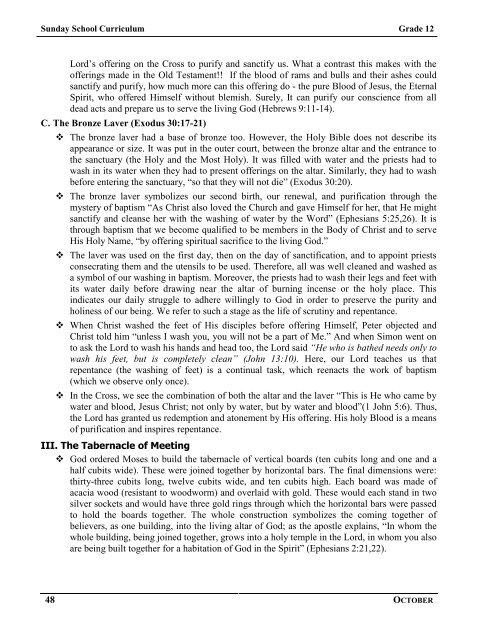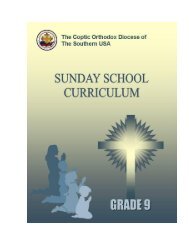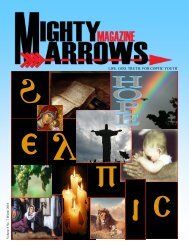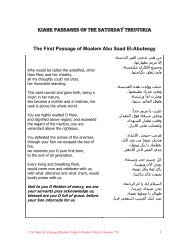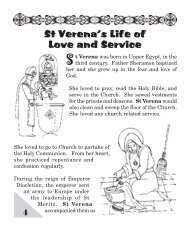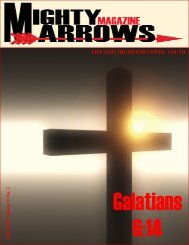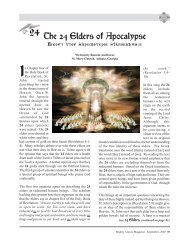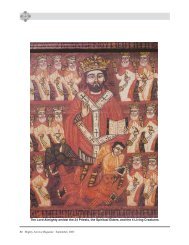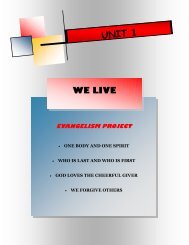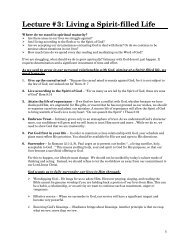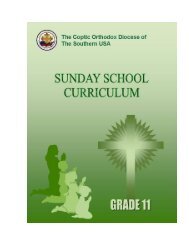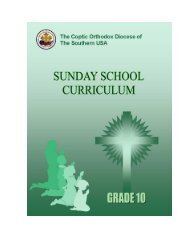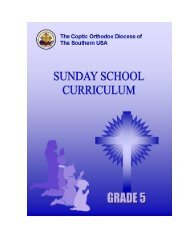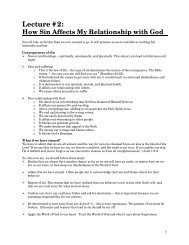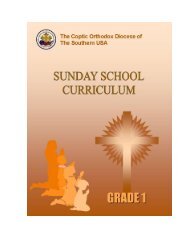Grade 12 - Coptic Orthodox Diocese of the Southern United States
Grade 12 - Coptic Orthodox Diocese of the Southern United States
Grade 12 - Coptic Orthodox Diocese of the Southern United States
Create successful ePaper yourself
Turn your PDF publications into a flip-book with our unique Google optimized e-Paper software.
Sunday School Curriculum <strong>Grade</strong> <strong>12</strong><br />
Lord‘s <strong>of</strong>fering on <strong>the</strong> Cross to purify and sanctify us. What a contrast this makes with <strong>the</strong><br />
<strong>of</strong>ferings made in <strong>the</strong> Old Testament!! If <strong>the</strong> blood <strong>of</strong> rams and bulls and <strong>the</strong>ir ashes could<br />
sanctify and purify, how much more can this <strong>of</strong>fering do - <strong>the</strong> pure Blood <strong>of</strong> Jesus, <strong>the</strong> Eternal<br />
Spirit, who <strong>of</strong>fered Himself without blemish. Surely, It can purify our conscience from all<br />
dead acts and prepare us to serve <strong>the</strong> living God (Hebrews 9:11-14).<br />
C. The Bronze Laver (Exodus 30:17-21)<br />
The bronze laver had a base <strong>of</strong> bronze too. However, <strong>the</strong> Holy Bible does not describe its<br />
appearance or size. It was put in <strong>the</strong> outer court, between <strong>the</strong> bronze altar and <strong>the</strong> entrance to<br />
<strong>the</strong> sanctuary (<strong>the</strong> Holy and <strong>the</strong> Most Holy). It was filled with water and <strong>the</strong> priests had to<br />
wash in its water when <strong>the</strong>y had to present <strong>of</strong>ferings on <strong>the</strong> altar. Similarly, <strong>the</strong>y had to wash<br />
before entering <strong>the</strong> sanctuary, ―so that <strong>the</strong>y will not die‖ (Exodus 30:20).<br />
The bronze laver symbolizes our second birth, our renewal, and purification through <strong>the</strong><br />
mystery <strong>of</strong> baptism ―As Christ also loved <strong>the</strong> Church and gave Himself for her, that He might<br />
sanctify and cleanse her with <strong>the</strong> washing <strong>of</strong> water by <strong>the</strong> Word‖ (Ephesians 5:25,26). It is<br />
through baptism that we become qualified to be members in <strong>the</strong> Body <strong>of</strong> Christ and to serve<br />
His Holy Name, ―by <strong>of</strong>fering spiritual sacrifice to <strong>the</strong> living God.‖<br />
The laver was used on <strong>the</strong> first day, <strong>the</strong>n on <strong>the</strong> day <strong>of</strong> sanctification, and to appoint priests<br />
consecrating <strong>the</strong>m and <strong>the</strong> utensils to be used. Therefore, all was well cleaned and washed as<br />
a symbol <strong>of</strong> our washing in baptism. Moreover, <strong>the</strong> priests had to wash <strong>the</strong>ir legs and feet with<br />
its water daily before drawing near <strong>the</strong> altar <strong>of</strong> burning incense or <strong>the</strong> holy place. This<br />
indicates our daily struggle to adhere willingly to God in order to preserve <strong>the</strong> purity and<br />
holiness <strong>of</strong> our being. We refer to such a stage as <strong>the</strong> life <strong>of</strong> scrutiny and repentance.<br />
When Christ washed <strong>the</strong> feet <strong>of</strong> His disciples before <strong>of</strong>fering Himself, Peter objected and<br />
Christ told him ―unless I wash you, you will not be a part <strong>of</strong> Me.‖ And when Simon went on<br />
to ask <strong>the</strong> Lord to wash his hands and head too, <strong>the</strong> Lord said “He who is ba<strong>the</strong>d needs only to<br />
wash his feet, but is completely clean” (John 13:10). Here, our Lord teaches us that<br />
repentance (<strong>the</strong> washing <strong>of</strong> feet) is a continual task, which reenacts <strong>the</strong> work <strong>of</strong> baptism<br />
(which we observe only once).<br />
In <strong>the</strong> Cross, we see <strong>the</strong> combination <strong>of</strong> both <strong>the</strong> altar and <strong>the</strong> laver ―This is He who came by<br />
water and blood, Jesus Christ; not only by water, but by water and blood‖(1 John 5:6). Thus,<br />
<strong>the</strong> Lord has granted us redemption and atonement by His <strong>of</strong>fering. His holy Blood is a means<br />
<strong>of</strong> purification and inspires repentance.<br />
III. The Tabernacle <strong>of</strong> Meeting<br />
God ordered Moses to build <strong>the</strong> tabernacle <strong>of</strong> vertical boards (ten cubits long and one and a<br />
half cubits wide). These were joined toge<strong>the</strong>r by horizontal bars. The final dimensions were:<br />
thirty-three cubits long, twelve cubits wide, and ten cubits high. Each board was made <strong>of</strong><br />
acacia wood (resistant to woodworm) and overlaid with gold. These would each stand in two<br />
silver sockets and would have three gold rings through which <strong>the</strong> horizontal bars were passed<br />
to hold <strong>the</strong> boards toge<strong>the</strong>r. The whole construction symbolizes <strong>the</strong> coming toge<strong>the</strong>r <strong>of</strong><br />
believers, as one building, into <strong>the</strong> living altar <strong>of</strong> God; as <strong>the</strong> apostle explains, ―In whom <strong>the</strong><br />
whole building, being joined toge<strong>the</strong>r, grows into a holy temple in <strong>the</strong> Lord, in whom you also<br />
are being built toge<strong>the</strong>r for a habitation <strong>of</strong> God in <strong>the</strong> Spirit‖ (Ephesians 2:21,22).<br />
48 OCTOBER


